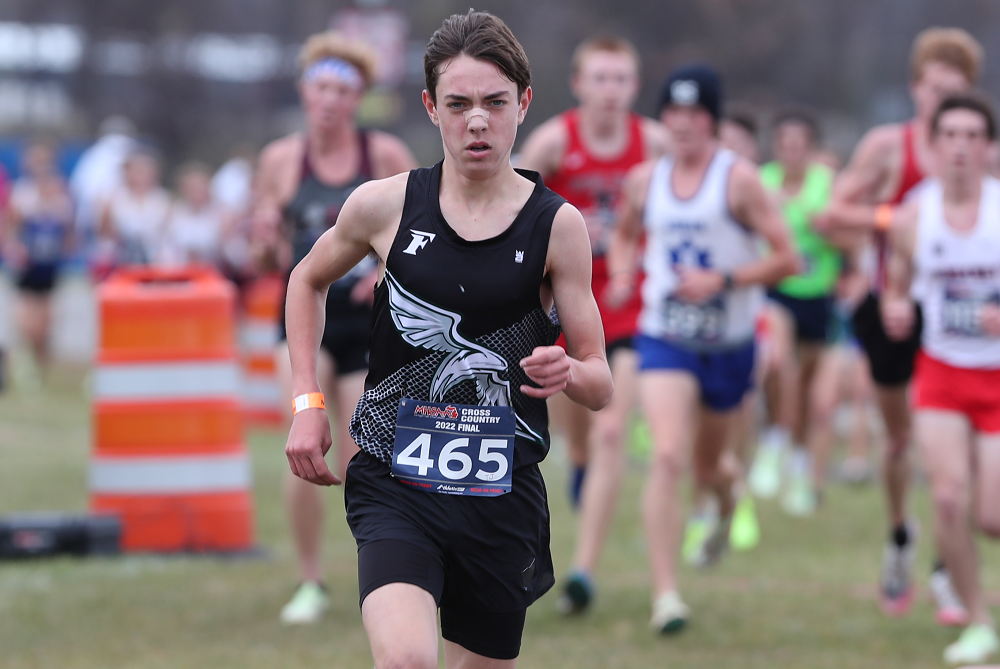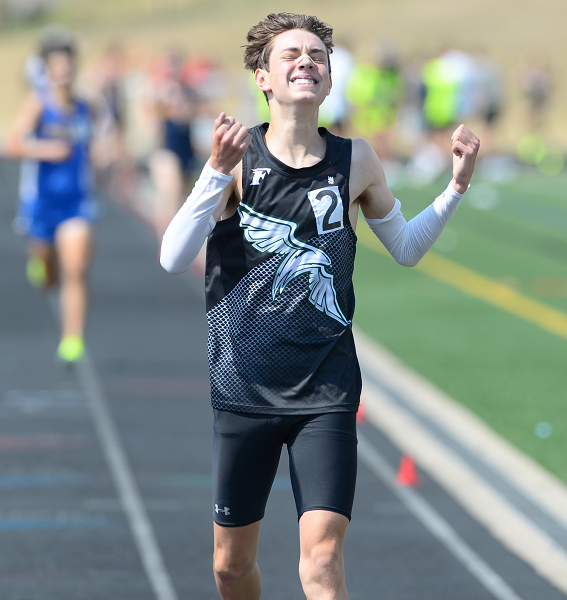
Saugatuck Follows Gorgas to 1st in D4
November 3, 2018
Second Half reports
BROOKLYN — Saugatuck senior Corey Gorgas raised his arms as he hit the finish line, but the day wasn’t all about him.
Moments after he completed a solo victory lap to the finish to win the MHSAA Lower Peninsula Division 4 individual cross country championship, he turned around and began looking for teammates.
He didn’t have to search for long.
One Saugatuck runner after another came streaming across the line, matching Gorgas’ individual dominance by placing five scoring runners within the top 30. The Indians scored 62 points to win their fourth MHSAA championship in six years by 40 over 2017 champion Mount Pleasant Sacred Heart on Saturday at Michigan International Speedway.
“Our (Nos.) 4 and 5 pulled through and had the race of their lives,” Gorgas said. “This is crazy. We won our sophomore year in D3, stayed in D3 last year and got killed. That was one of the hardest things I ever had to go through was the 12th-place finish. Coming back this year with young guys like Adam (Martinson) and new kids Tristan (Ashley) and Winston (Marcy), for them to pull through and get us a state championship like that means so much. I’m just so happy right now we pulled this off.”
Gorgas became Saugatuck’s first individual champion with a time of 15:33.8. Sophomore Nik Pettinga was third in 16:18.0, freshman Max Sharnas 15th in 17:04.9, senior Ray Bartlett 28th in 17:11.4 and junior Winston Marcy 30th in 17:16.5. All five scoring runners made all-state.
Sacred Heart had solid depth, but couldn’t match Saugatuck’s strength up front. The Irish’s first runner was 17th-place T.J. Moore (17:06.7). Sacred Heart put five runners in the top 35, with Brook Lynch taking 20th (17:07.2), Chase Nelson 21st (17:07.3), Matthew Nowak 33rd (17:30.2) and Josh Lynch 35th (17:33.7).
 “We were going against the defending champ,” Gorgas said. “They have a great team, great coach, great program. We knew they were going to be tough to beat. We put in a lot of work this summer. I’m glad the guys were able to pull it off with me.”
“We were going against the defending champ,” Gorgas said. “They have a great team, great coach, great program. We knew they were going to be tough to beat. We put in a lot of work this summer. I’m glad the guys were able to pull it off with me.”
Gorgas ran the fifth-fastest winning time in Division 4 in the 20 years of the divisional format for cross country.
He won seven of eight meets this year, finishing second by 4.1 seconds to 2017 Division 1 champion Nick Foster of Ann Arbor Pioneer in the Spartan Elite race at the Spartan Invitational on Sept. 14. That race featured many of the top teams in Divisions 1 and 2.
It was the fourth all-state performance for Gorgas, who was 11th in Division 4 as a freshman, then fourth in the last two Division 3 races. He’s the first Saugatuck boy to win an MHSAA individual title.
“It was definitely different, especially last year, being in Division 3, I had so many guys (around me),” Gorgas said. “I was fourth last year. That was a rough race. Coming back down this year, being able to focus and train through a lot of this stuff so I could focus on postseason meets was huge for me.”
Gorgas hit the mile mark in 5:00.12, holding a five-second lead over Luke Pohl of Plymouth Christian. Gorgas stayed strong with a 5:02.05 second mile to expand his lead to 21 seconds.
“Luke Pohl got out pretty hard, so I kind of caught him around the 800-meter mark,” Gorgas said. “I went around him there to throw in a big surge so I could pull away from him. From the mile in, I was all alone.”
PHOTOS: (Top) Saugatuck’s Corey Gorgas pushes through the closing stretch in winning the Division 4 individual championship Saturday. (Middle) Gorgas and Nik Pettinga, right, embrace after Pettinga crossed in third place. (Click for more from RunMichigan.com.)

Freeland's Hansen Not Focused on Joining All-Time Greats - But On His Way
By
Paul Costanzo
Special for MHSAA.com
September 29, 2023
The goal written on Matt Kaczor’s Post-It Note was sub-15 minutes, 15 seconds. That’s what the Freeland cross country coach was hoping for from star runner TJ Hansen during his junior season.
 Kaczor tore it up after seeing Hansen run a single race this fall.
Kaczor tore it up after seeing Hansen run a single race this fall.
“Knowing what he did over the summer and where he was at, seeing what his 1,600 (meter) and his mile got down to, I had a feeling he could get under 15:30 quickly,” Kaczor said. “After the first race, I looked at my assistant and was like, ‘I’ve gotta rip up that Post-It Note. I don’t think our goal is on the level of where he’s at right now.’ At first, it was break 15:15. Once I saw him race at the Under the Lights (on Aug. 18 at St. Johns), I was like, ‘Yeah, he’s going sub 15.’”
Hansen ran 15:39.6 in that first race, and on Sept. 7, in Shepherd, he ran 15:13.9 to meet the goal written on the now-shredded Post-It Note.
This past Saturday, he ran 15:03.7 at the Cadillac Veterans Serving Veterans Invitational. It’s the fastest time recorded in Michigan this year, and a signal that Kaczor might be filling out a new Post-It Note before the season is out.
“The sub-15 barrier, that’s been something on my mind for a while,” Hansen said. “Now that I’m edging closer and closer to that, it’s been exciting. With how heavy my training has been, I wouldn’t expect (to have run this fast this early). Being able to run the times I am really paints the picture for what’s ahead.”
Hansen came into the season already regarded as one of the elite distance runners in the state. He won the 3,200 meters at the MHSAA Lower Peninsula Division 2 Track & Field Finals this past spring. He’s also finished all-state (12th and fifth, respectively) the past two seasons at the LPD2 Cross Country Finals.
His current trajectory, however, would put his name near some of the state’s all-time greats. But that’s not something Hansen is focusing on.
“I really don’t like to compare myself to others,” he said. “I don’t focus on that. I try to be the best TJ Hansen that I can be. The best version of myself.”
Focusing on himself is almost necessary for Hansen, as he’s spending a lot of time during his races running by himself.
At each of the big events Freeland has run in this season, Hansen has finished at least 20 seconds ahead of his nearest competitor. That includes all divisions of the Duane Raffin Festival of Races in Holly.
In Cadillac, where Hansen ran his current best time, he was a full minute ahead of the rest of the field.
 “He’s just a special athlete,” Kaczor said. “I can’t see Freeland having someone like this in a while. He’s a generational talent. What’s crazy is, I had the school record when he was a freshman. He and Braden (Honsinger) broke it last year. But TJ has now dropped that school record (set in 1998) by almost a minute.”
“He’s just a special athlete,” Kaczor said. “I can’t see Freeland having someone like this in a while. He’s a generational talent. What’s crazy is, I had the school record when he was a freshman. He and Braden (Honsinger) broke it last year. But TJ has now dropped that school record (set in 1998) by almost a minute.”
Hansen’s achievements have already put him on a path to run at the next level, which is something of a family tradition.
His older sisters Peyton and Kiera are track & field athletes at Wayne State and Eastern Michigan, respectively. Their parents, Tim and Pam, were track & field stars at Central Michigan.
TJ has drawn the attention of coaches around the country, including from Michigan, Michigan State, Wisconsin, Tennessee and Colorado.
Having family members who know the process is a help for Hansen, and he said they’ve all been good about allowing him to choose his own path, whatever that may be.
“He’s from a good family that knows how to work and knows how to get things done,” Kaczor said. “He knows that if he puts in the work, he’s going to be at a good spot.”
While Hansen admits it can be a bit overwhelming, he’s using it as motivation to run faster and continue to put his name out there.
Also serving as motivation is 2022 Division 2 champion Connell Alford of Chelsea. Alford is among the elite group of runners in Michigan who have broken the 15-minute mark, doing it twice a year ago.
He currently has the state’s second-best time behind Hansen’s this year, running 15:09.1 at the MSU Invitational on Sept. 15.
“Whenever I see him drop a time, my main goal is to run faster,” Hansen said. “Whenever I see him run a good time, that motivates me to work hard.”
The two won’t see each other until the MHSAA Finals on Nov. 4 at Michigan International Speedway. It’s an opportunity Hansen is excited for, as it’s a chance to race and be pushed toward the lofty goals he’s set for himself. Kaczor is excited about it, too, even if it might mean having to replenish his supply of Post-Its.
“We don’t talk about winning the state title; we talk about making sure that we have great races on those days,” Kaczor said. “We can’t control how somebody else runs. It’s a matter of can we, if the weather is right and the course is in good condition, can we be one of the few guys that has run in the 14s on that course? That’s the goal. Put yourself in some great categories with those upper echelons and the greats of all-time.”
 Paul Costanzo served as a sportswriter at The Port Huron Times Herald from 2006-15, including three years as lead sportswriter, and prior to that as sports editor at the Hillsdale Daily News from 2005-06. He can be reached at [email protected] with story ideas for Genesee, Lapeer, St. Clair, Sanilac, Huron, Tuscola, Saginaw, Bay, Arenac, Midland and Gladwin counties.
Paul Costanzo served as a sportswriter at The Port Huron Times Herald from 2006-15, including three years as lead sportswriter, and prior to that as sports editor at the Hillsdale Daily News from 2005-06. He can be reached at [email protected] with story ideas for Genesee, Lapeer, St. Clair, Sanilac, Huron, Tuscola, Saginaw, Bay, Arenac, Midland and Gladwin counties.
PHOTOS (Top) Freeland's TJ Hansen leads a pack during last season's LPD2 Final at Michigan International Speedway. (Middle) Hansen enjoys a moment of exhilaration after winning the 3,200 this spring at the LPD2 Finals at Ada Forest Hills Eastern. (Top photo by Carter Sherline/Run Michigan; middle photo by Dave McCauley/Run Michigan.)

